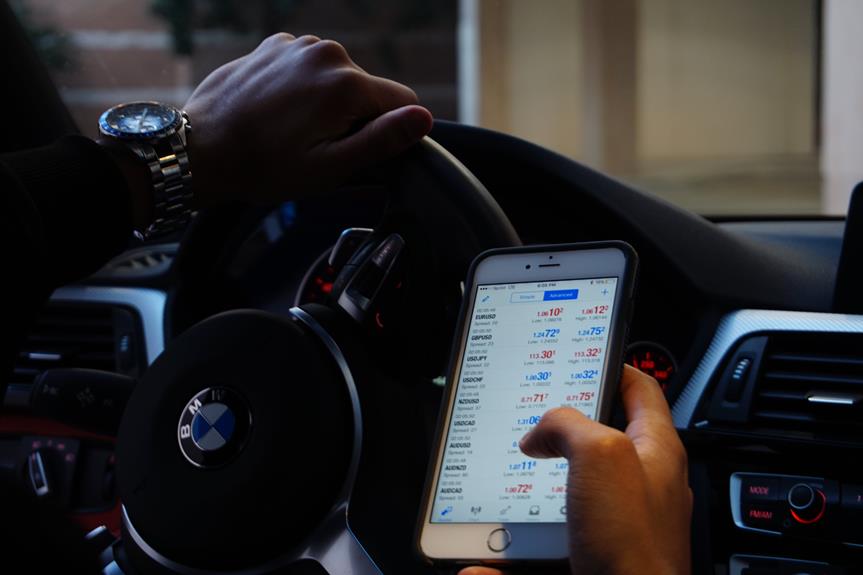In the vast ocean of Forex trading, your toolset is the compass guiding you through turbulent waters. You’ve got to blend analytical prowess with the right technological tools to navigate market currents smartly.
Developing a custom Forex trading toolset isn’t just about choosing the shiniest gadgets; it’s about selecting tools that resonate with your unique trading fingerprint. From algorithms that predict market trends to dashboards that visualize complex data, each element must serve a purpose.
The journey to constructing such a toolkit requires a blend of strategy, patience, and innovation. Now, the question remains: are you ready to chart the course?
Key Takeaways
- Tailor your toolkit to match trading style, incorporating technical indicators and advanced charting for informed decisions.
- Integrate real-time news and social trading platforms for actionable insights and strategy mirroring.
- Employ risk management tools, like stop-loss orders, to safeguard investments and ensure capital preservation.
- Commit to continuous learning and algorithm optimization for adapting to market changes and enhancing trading performance.
Identifying Your Needs

Identifying Your Needs
Before crafting your custom Forex trading toolset, it’s crucial to assess your specific trading requirements, including the frequency of your trades, your risk tolerance, and the strategies you prefer. This foundational step is imperative for developing a Forex trading system that not only aligns with your financial goals but also complements your market engagement style. Whether you’re gravitating towards short-term speculation or long-term investment, the complexity and functionality of your tools must reflect your operational depth and expertise in the Forex domain.
Your toolkit’s efficacy hinges on integrating the right blend of tools and features. These should include advanced charting tools for technical analysis, a variety of technical indicators to decipher market trends, and diverse order types to execute your strategies effectively. Moreover, real-time market data, access to historical data, and news sources are invaluable for informed decision-making.
Considering automated trading strategies? Your system should seamlessly accommodate this preference, ensuring you can capitalize on market opportunities round the clock without manual intervention. Remember, a meticulously assembled Forex trading toolkit empowers you to navigate the volatile Forex market with precision, leveraging price movements to your advantage.
Exploring Software Options
Having established your trading needs, it’s essential to evaluate the software options available to forge your custom Forex trading toolkit. In the realm of Forex trading, the selection of your software can significantly impact your performance.
Diverse platforms like Ninja Trader offer a basic entry point with opportunities to expand through purchases of historical and live forex market data. For those seeking advanced capabilities, Wealth Lab, at a higher price point, provides a broader array of add-ons and features, catering to the nuanced needs of sophisticated traders.
On the online trading front, Tradesignal.com allows for the creation and testing of automated systems, marking a pivot towards algorithmic trading in the financial markets. Similarly, IG Index leverages advanced charting from ProRealTime, enhancing decision-making with superior visual data analysis, available at no extra cost for active traders.
Meta Trader stands out for its widespread adoption among forex brokers, offering the flexibility to develop custom indicators and robots. This platform requires a deeper dive into coding, appealing to traders who prioritize customization and automated systems in their strategy.
Each of these platforms brings unique risk management tools, essential for navigating the volatile Forex market effectively. Your choice should align with your trading style, whether it leans more towards manual analysis or algorithmic trading.
Analytical Tools Selection

Analytical Tools Selection
In selecting analytical tools for forex trading, you must prioritize those that offer insightful market analysis and support informed decision-making. As a trader aiming for mastery, understanding which tools align best with your strategy is crucial. Your toolkit should include a mix of technical indicators, charting software, and economic calendars to ensure a comprehensive analysis of market trends and potential price movements.
Technical indicators such as Moving Averages, Fibonacci retracement levels, the Relative Strength Index (RSI), and Bollinger Bands are indispensable. These tools help you identify prevailing market trends, key support and resistance levels, and potential entry and exit points, enhancing your ability to make well-informed trades. The Moving Averages, for instance, can signal the direction of the market trend, while Fibonacci retracement levels offer insight into potential reversal points. The RSI helps gauge the market’s momentum, and Bollinger Bands can alert you to market volatility.
Incorporating a robust selection of analytical tools into your forex trading strategy isn’t just about data analysis; it’s about refining your decision-making process. By methodically selecting and utilizing these tools, you’ll be better positioned to execute trades with confidence, improving your overall trading performance.
Integrating News Feeds into your Custom Forex Trading Toolset
After equipping yourself with essential analytical tools, integrating news feeds into your forex trading strategy becomes the next critical step to enhance your market insight and decision-making prowess. News feeds offer real-time updates on market-moving events, economic indicators, and geopolitical developments, crucial for making informed decisions. By incorporating news feeds, you’re not just reacting to the market; you’re anticipating it, giving you a strategic edge.
| Feature | Benefit | Impact on Trading |
|---|---|---|
| Real-time updates | Immediate insight into market movements | Enhances decision-making speed |
| Economic indicators | Understanding of global economic health | Improves trading strategies |
| Geopolitical news | Awareness of political events’ market impact | Bolsters risk management |
Integrating news feeds into your toolset elevates your market awareness, allowing you to stay ahead of trends and potential market shifts. This integration not only informs your trading strategies but also refines your risk management by providing a broader context of the market’s direction. With this level of insight, you’re better positioned to navigate the complexities of the forex market, ensuring that your trading strategy is both responsive and proactive to the ever-changing landscape.
Embracing Social Trading

Embracing Social Trading
Embracing social trading revolutionizes your approach by allowing you to mirror the strategies of seasoned traders, significantly enhancing your learning curve and potential for success. Platforms like eToro and ZuluTrade provide a gateway to this innovative world, where novice traders gain invaluable insights from the experiences of successful traders.
Here’s how you can harness the power of social trading to diversify your portfolio and elevate your trading skills:
- Follow Top Performers: Identify and follow experienced traders who consistently demonstrate profitable trading strategies. This allows you to learn from their expertise and apply similar tactics to your trading endeavors.
- Diversify Your Portfolio: By copying multiple traders with varied trading styles and strategies, you effectively spread your risk and tap into different markets and instruments, thereby diversifying your investment portfolio.
- Engage in Community Collaboration: Leverage the community aspect of social trading platforms for collaboration and knowledge sharing. Engaging with a network of traders fosters a learning environment where you can discuss strategies, receive feedback, and stay updated on market trends.
Social trading bridges the gap between novice and experienced traders, offering a platform for knowledge sharing and community collaboration, crucial for mastering the complex world of Forex trading.
Risk Management Techniques
To effectively mitigate risks in your forex trading endeavors, it’s crucial to incorporate proven risk management techniques within your strategy. Implementing stop-loss orders in your custom forex trading toolset is foundational. These orders work tirelessly to minimize losses and protect capital, even when you’re not actively monitoring the markets. Additionally, trailing stops are indispensable for securing profits while managing the risk of potential market reversals. They allow you to stay in the game by automatically adjusting to the market’s highs, ensuring you’re not left behind during sudden shifts.
Diversifying your trading portfolio is another methodical approach to spread risk and minimize exposure to individual currency fluctuations. It’s a strategic move that demonstrates a disciplined trading approach, ensuring that a setback in one area won’t devastate your entire trading operation.
Your ability to adapt risk management strategies to changing market conditions is pivotal. This agility allows you to adjust your trading approach, ensuring your methodology remains relevant and effective regardless of market dynamics. Incorporating these risk management techniques into your custom forex trading toolset is non-negotiable for traders aiming to maintain a disciplined and strategic approach to forex trading.
Testing and Optimization

Testing and Optimization
While incorporating risk management techniques is foundational, you must also prioritize testing and optimization to refine your forex trading strategy for peak performance. This phase is critical in developing your custom toolset for navigating the forex trading landscape with precision and adaptability.
Here are three essential steps to ensure your trading algorithms aren’t just surviving but thriving:
- Back-testing Historical Data: It’s imperative to back-test your trading algorithms against historical market conditions. This step not only validates the robustness of your strategy but also identifies potential areas for improvement. Regular back-testing ensures your approach remains relevant and effective.
- Optimization through Advanced Tools: Utilize optimization tools such as genetic algorithms or machine learning to fine-tune the parameters of your automated trading systems. This process is vital for enhancing profitability while minimizing risks. Optimization helps in adapting your strategy to the ever-evolving market conditions.
- Regular Testing and Optimization Cycles: Commit to ongoing testing cycles. The forex market is dynamic, and staying ahead requires that your custom toolset evolves through continuous optimization. This iterative process is key to maintaining competitiveness and achieving long-term success.
Continuous Learning and Adaptation
In the ever-evolving world of forex trading, continuous learning and adaptation stand as pillars for sustained success, requiring traders to stay abreast of market shifts, economic signals, and global events. You’re tasked with not just following but deciphering market trends, allowing you to refine your trading strategies effectively. It’s about leveraging the latest trading tools and adjusting your risk management techniques to safeguard your investments against volatility.
Utilizing educational resources, such as webinars, online courses, and trading journals, becomes indispensable for your skill development. These platforms offer a wealth of knowledge, helping you to understand complex market dynamics and refine your approach. Regularly analyzing your trading performance metrics is crucial. It’s through this analysis of trading decisions that you identify areas ripe for improvement, turning weaknesses into strengths.
Engagement with trading communities and forums, alongside engaging with mentors, enriches your learning journey. Here, shared experiences and insights spark innovation, encouraging a culture of continuous improvement. Remember, the path to mastery in forex trading is iterative. It demands a methodical approach to learning and adaptation, where refining strategies, embracing new tools, and engaging with the wider trading community aren’t just beneficial but essential for your success.
Frequently Asked Questions
Can I Create My Own Forex Robot?
Yes, you can create your own forex robot. By leveraging programming languages like MQL for MetaTrader platforms, you’ll be able to encode your trading strategies into an automated system.
This process involves designing your robot to follow specific risk management rules, entry/exit criteria, and trade parameters that align with your unique trading style. However, it requires a deep understanding of technical analysis, trading indicators, and thorough backtesting to ensure your strategy is viable.
How Do I Create My Own Forex System?
To create your own forex system, you’ll need to dive deep into market analysis, understanding indicators, and risk management strategies. Start by researching market trends and historical data, then develop and back-test your strategies rigorously.
You’ll also need to learn programming languages like Python or MQL4 to automate your system. It’s crucial to continuously monitor and tweak your system to keep it aligned with the ever-changing market conditions, ensuring optimal performance.
How to Build a Forex Trading Model?
To build a forex trading model, you’ll identify your key trading parameters like entry/exit points, risk tolerance, and position sizing.
You’ll backtest using historical data to evaluate its performance across various conditions.
Incorporating technical indicators, chart patterns, and fundamental analysis will enhance its accuracy.
Don’t forget about risk management strategies such as stop-loss orders to protect your capital.
Continuously optimize based on real-time feedback for better results.
How to Build an Automated Forex Trading System?
To craft your automated forex trading system, you’ll start by programming your digital ally to sift through market data, spotting opportunities using your chosen indicators. You’ll weave in your risk management strategies and trade execution rules, ensuring it acts as an extension of your trading philosophy.
Don’t forget to rigorously test and optimize, a step that turns a good system into a great one. This approach guarantees your trading operates smoothly around the clock, free from emotional hiccups.
Conclusion
So, you’ve ventured into crafting your custom forex toolset, meticulously selecting software, integrating news, and even dabbling in social trading.
Ironically, after all this precision, the market still has its way of humbling us with its unpredictability. Remember, despite our best efforts and sophisticated tools, the market’s whims can render them mere toys at times.
Keep testing, adapting, and learning. The true skill lies not just in building your arsenal but in the art of continually refining it amidst the market’s capricious nature.

